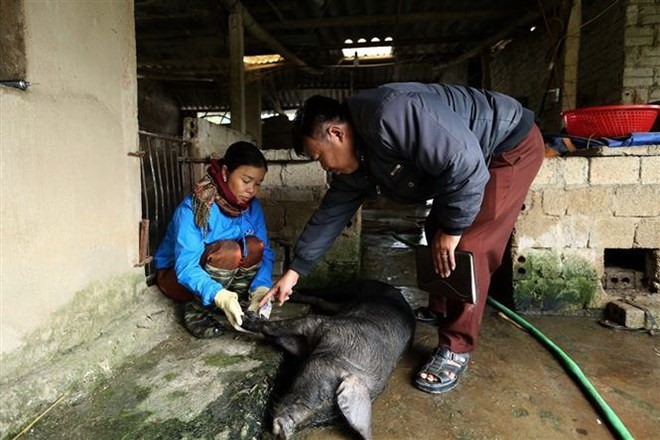 Society
Society

The foot-and-mouth epidemic has affected pigs in five districts in Lạng Sơn province since December 23, according to Nguyễn Nam Hùng, director of the provincial Department of Animal Health on Tuesday.
 |
| A veterinary worker (right) checks a pig suspected of having foot-and-mouth disease in Lạng Sơn Province. — VNA/VNS Photo Phan Tuấn Anh |
LẠNG SƠN — The foot-and-mouth epidemic has affected pigs in five districts in Lạng Sơn Province since December 23, said Nguyễn Nam Hùng, director of the provincial Department of Animal Health on Tuesday.
The five districts included Bình Gia, Chi Lăng, Văn Quan, Bắc Sơn and Hữu Lũng. The epidemic started in Tô Hiệu and Văn Thụ communes of Bình Gia District, before spreading to others.
All pigs suspected of contracting the disease were culled.
Each household with culled pigs received financial support at VNĐ35,000 (US$1.5) per kilo of pig.
Experts said that the epidemic was caused by poor hygiene standards during the slaughtering process. Recent cold weather and rains had reduced pigs’ resistance to the disease.
After discovering the cases, the provincial Department of Animal Health collaborated with local authorities to conduct prevention and control methods to limit losses of livestock.
Nearly 20,000 doses of vaccine and more than 1,000 litres of antiseptic were delivered to districts. The districts also bought nearly 10 tonnes of powdered lime to spread in breeding cages.
At present, the provincial experts are keeping a close watch on the animals to monitor new affected areas and prepare prompt responses.
In another development, Nguyễn Ngọc Sơn, director of the Hà Nội Department of Animal Health, said that since November 12, the capital city saw four districts with foot-and-mouth disease including Quốc Oai, Ba Vì, Đan Phượng and Thường Tín.
As many as 858 pigs were culled.
After one month of conducting prevention and control methods, Ba Vì and Thường Tín districts are still struggling with the disease. — VNS




